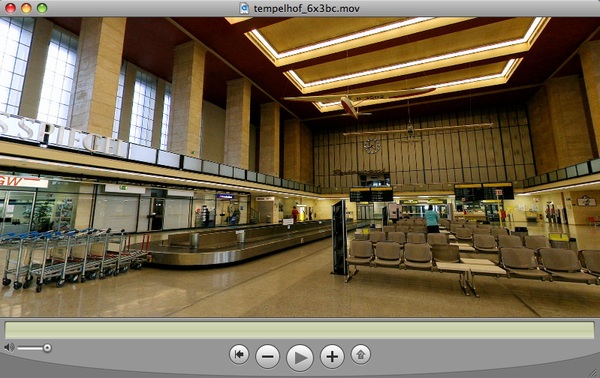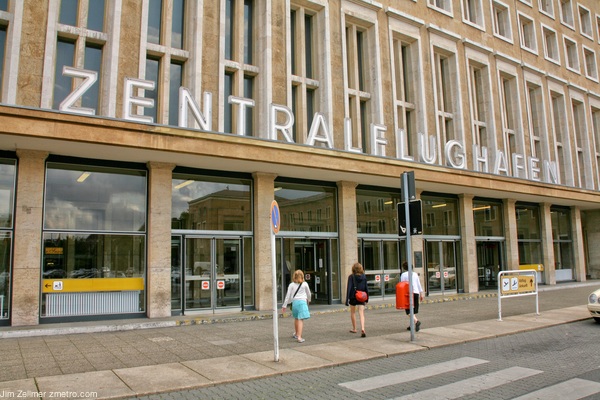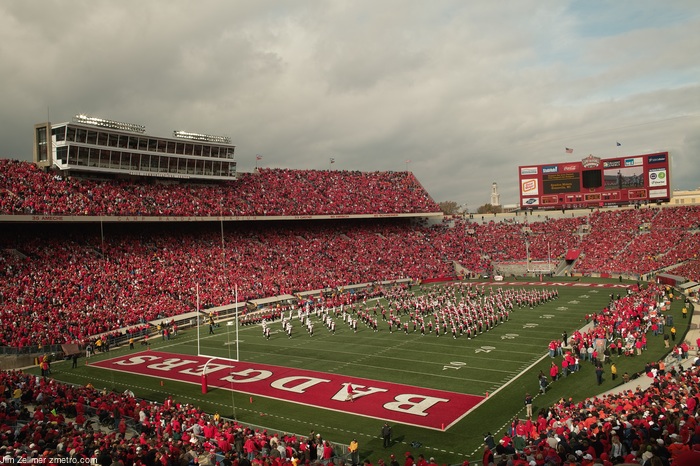
Wisconsin polling locations can be found here.
Flughafen Tempelhof Closes: VR Scene

Tempelhof Central Airport (52.482088 13.389716), home of the Cold War era Berlin Airlift closed recently. I had an opportunity to visit in August, 2007 and shot this VR scene.
Flight Global posted a useful link roundup.

A few more photos: Tempelhof entrance, nearby Berlin Airlift Memorial and a closer look (photo from the Memorial’s 1951 unveiling).
Berlin Airports: Tempelhof – from the beginning till today. “An important chapter in the history of German aviation draws to a close“:
Tempelhof is justifiably regarded as the cradle of aviation. The name Tempelhof is closely connected to the beginning of engine-powered aviation. On 4 September 1909, an engine-powered flight took off for a few minutes for the first time in Germany. With his plane, American Orville Wright ushered in the age of engine-powered aviation in Germany on the Tempelhof airfield. Aeronautical engineering continued to develop at a rapid pace: on 8 October 1923, Tempelhof was granted the status of “Berlin Airport”. The central airport Tempelhof developed into the biggest hub in Europe. Tempelhof became the home of Deutsche Lufthansa AG, which was founded on 6 January 1926 in Berlin. 1936 saw the start of construction of a completely new airport of epic proportions. The construction of the largest airport building in the world catered for both Hitler’s penchant for monumental constructions and the expected 6 million passengers. During World War II, civilian air traffic increasingly dwindled. After a brief occupation by the Soviet army, the Americans took over the airport in July 1945.
Quintessential Madison: Halloween 2008

An in-costume cyclist early Saturday morning. Madison, WI.
Another very Madison Halloween image, this time, an older couple:
Obama’s Secret Weapons: Internet, Databases and Psychology
During a sweltering Friday evening rush hour in early October, Jeanette Scanlon spent two-and-a-half hours with 20 other people waving a homemade Barack Obama sign at the cars flowing through a busy intersection in Plant City, Florida.
“I got shot the bird one time,” laughs the easy-natured Scanlon, a 43-year-old single mother of three and a Tampa psychiatrist’s billing manager. “That wasn’t the thumbs up I was looking for.”
Scanlon is one of an estimated 230,000 volunteers who are powering Obama’s get-out-the-vote campaign in the swing state of Florida. And while sign-waving is a decidedly low-tech appeal to voters’ hearts and minds, make no mistake: The Obama campaign’s technology is represented here. Scanlon organized the gathering — and 24 others since September — through Obama’s social networking site, my.BarackObama.com. Similarly, she used the site’s Neighbor-to-Neighbor tool in September to find registered voters in her own neighborhood, so she could canvass them for Obama. And this weekend, Scanlon and another 75 or so Plant City volunteers will be phoning thousands of Floridians to urge them to vote, using a sophisticated database provided by the Obama campaign to ensure they don’t call McCain supporters by mistake.
The Obama campaign has been building, tweaking and tinkering with its technology and organizational infrastructure since it kicked off in February 2007, and today has most sophisticated organizing apparatus of any presidential campaign in history. Previous political campaigns have tapped the internet in innovative ways — Howard Dean’s 2004 presidential run, and Ron Paul’s bid for this year’s Republican nomination, to name two. But Obama is the first to successfully integrate technology with a revamped model of political organization that stresses volunteer participation and feedback on a massive scale, erecting a vast, intricate machine set to fuel an unprecedented get-out-the-vote drive in the final days before Tuesday’s election.
A friend recently mentioned that one of the canvasers asked if they could leave an orange dot on their mailbox, notifying other workers that they have already voted! I wonder how long it will be until citizens push back on the extensive personal data mining.
Faces in the Crowd: Halloween 2008

Flyover Country

Flyover Country; a sunrise view from Fitchburg.
Wisconsin Hockey vs. Minnesota Golden Gophers

A tough weekend series for Bucky; a Friday evening tie (2-2) and a Saturday 5-1 loss.
A “Carbon Neutral” College Football Game: Wisconsin vs. Illinois
As part of a campuswide commitment to reducing our environmental footprint, the Badgers’ Homecoming game against the University of Illinois on Saturday, Oct. 25, has been designated a “carbon-neutral” game.
The game, the first of its kind in the Big Ten and one of the first in the nation, will offer a chance to raise awareness of environmental issues, such as the damaging effects of carbon dioxide and the benefits of conservation and recycling. The event will also provide information on ways fans can take action in their daily lives to become more environmentally friendly.
The game is also a way to highlight the Athletic Department’s plans to implement a recycling and sustainability plan during the next five years.
“We’re hoping this game will stimulate more awareness of environmental issues on the part of Badger fans everywhere and demonstrate the many ways in which athletics and the rest of our campus are making meaningful commitments to sustainability,” says Chancellor Carolyn “Biddy” Martin.
The project has two aims: to offset carbon dioxide emissions generated directly by activities surrounding the game, and to make a continuing investment in a healthy environment by planting trees.
Wisconsin vs. Illinois: A Working Face in the Crowd
Fall Colors: Afternoon Light

Milwaukee

